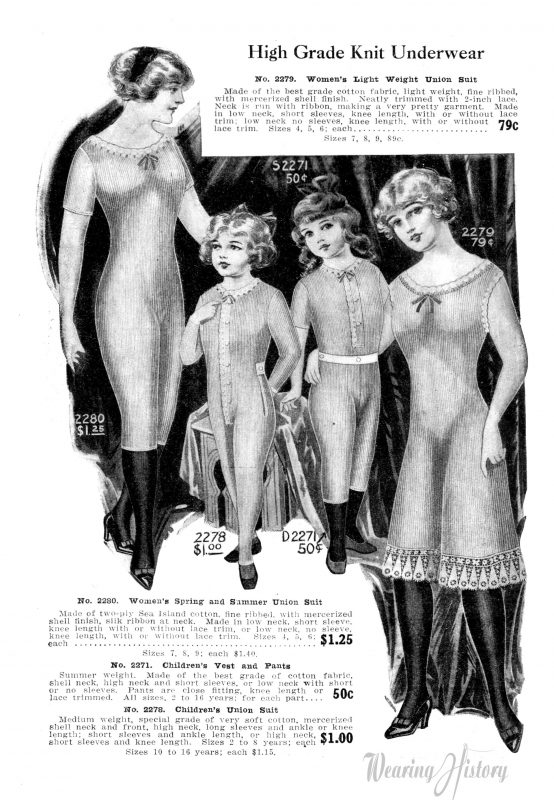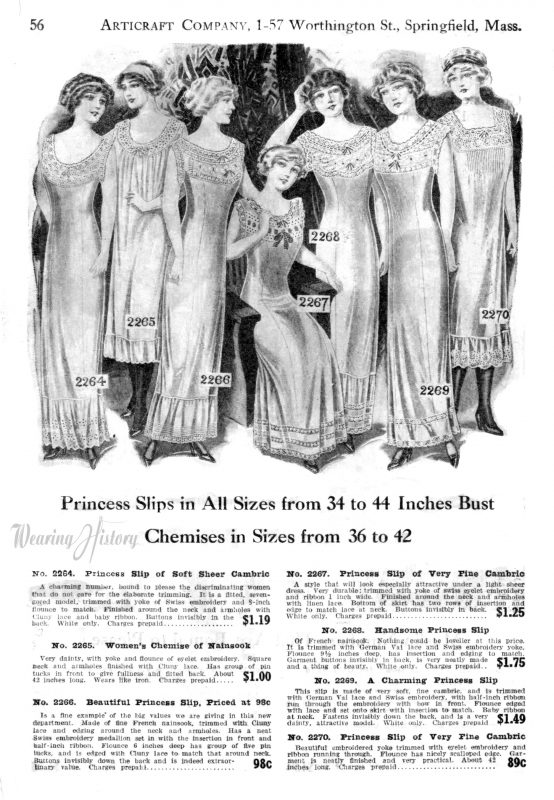There can’t be too many people who get as thrilled as I do when variations of knit combination suits come up in original period sources! And another geeky love- when the combinations mention what the type of combination was for. There’s a modern misconception that combination undergarments were only worn *under* the corset, but as my research into period documents shows, there were varieties on what order and what type of combination could be worn for each fashion.
If you’re not sure what I’m on about, you can read some of my prior research here. The short version- knit vests or “union suits” or “knit combinations” were vastly preferred for underneath, if omitting a chemise. The over the top kind usually were indicated by saying “corset cover and drawers” or “corset cover and petticoat”, thus distinguishing that it was combining those two garments and would be worn on top. For more 1910s underwear geekery, check out my video here, where I show some original garments.
Here, we are lucky to get in the same catalog from 1914 (called Artikraft), both the *under* kind, and the *over* kind. I’m also including the page of princess slips, for a full visual of the range of “all in one” pieces that were making the rounds in the 1910s. Many thanks to my friend, Ginger, who found me this original period catalog at an estate sale so I can share the images with you.
These knit combinations or “union suits” would be worn underneath the corset and have split drawers. As you can see here, they were available for the entire family- there’s even a page for the men in this catalog, but I’m focusing on the women in this instance. For more information about knit combinations, please click my link above. I go into much more detail about them on the other post!
And here we have the woven combinations. These would be worn on top of the corset, as in each description it says “corset cover and drawers” or “corset cover and petticoat”. If these were the underneath kind, they would be indicated by a description such as “combination chemise and drawers”
When the combination is of the type that is for “corset cover and petticoat”, it is safe to say there was some sort of drawers worn underneath the corset. This could be a knit combination suit, or traditional woven drawers and chemise. As the century progressed, the woven chemise was phasing out, but you still see the knit combination suits well into the 1940s.
If the combination type says “corset cover and drawers”, then it’s safe to say that there would not be another set of drawers underneath the corset. Underneath would be a knit “vest” (basically a long tank top), or a traditional woven chemise. You would *most likely* wear a petticoat on top of the combination, though I need to research this more in depth before I can say for certainty what the preferred mode of petticoat would be.
And here we have princess slips. Notice that the two chemises are put on this page, but are in the backdrop- which was typically done with less fashion-forward styles that were still somewhat in demand, but were phasing out.
It stands to reason that a princess slip would most likely *not* be worn on top of the combination, regardless of what I previously did when prepping for my 1908 themed wedding trousseau. Based on my current research, the slimming down of the underwear was in vogue, so it’s most likely that the princess slip reached peak height of the slimmed silhouette and would be- from the base out- a knit combination suit or vest, the corset, and then the princess slip. A chemise, corset, combination, then princess slip would be overkill for the amount of layers that went under the directoire silhouette of the 1908-1914 period. With the corset, that makes four layers on the upper torso before we even add a dress or blouse! If you added a brassiere or bust improver that would be even more! So it stands to reason that there would be one later for next to the skin, then the corset, then one layer to cover the corset and protect the gown.
The princess slip was specifically designed to be worn under princess dresses- which would be a dress without a waist seam. There were “semi-princess dresses” as well, which usually featured a front panel without a waist seams and side panels with. For either of these styles, especially in the sheer cottons that were so fashionable, the princess slip would be the preferred underwear as it would not create a line at the waist and retain the smooth front line. This is not to say that women didn’t wear them under other dresses as well, but their original intended purpose was for the dresses that were cut all in one in the princess line. Having worn one underneath a two-piece dress, I can tell you, I believe it would have been more comfortable to have a combination corset cover and petticoat, as I felt like the princess slip was fighting at odds with my dress- the dress with a set waistband and the princess slip cut loosely (as they sometimes did when moving in the 19-teens especially).
Of course, we get poufy petticoats back in 1915-1916 (with 1916 at it’s height, when even hoop skirts made a small resurgence), but the austerity of wwi, and the slim skirted lines of the late teens into the 1920s, meant we were back to the slim underwear line once again.
I hope these help clarify, via a period source, what types of underwear could be available and their purpose.
If you’re after combination sewing patterns, please do check out my Etsy or pattern shop. I have both “combination chemise and drawers” and “Combination corset cover and drawers OR petticoat” available that were remastered from rare period originals.



